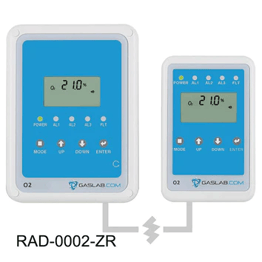By: Craig Pagano on June 21st, 2023
Pressurized Gas & Oxygen Levels: How to Stay Safe
From carbonating beverages to food packaging to medical treatments, pressurized gas touches nearly every part of our daily lives, whether we realize it or not. But keeping gases under pressure isn’t without highly dangerous and life-threatening risk. A lot can go sideways, and quickly, if proper safety protocols aren’t followed.
Pressurized gas leaks: What can go wrong.
First, a quick overview. There’s pressurized gas and then a subset of those gases known as cryogenics – essentially anything kept at a temperature below 120 Kelvin (-244°F or -153°C) is considered cryogenic.
At these temperatures, nitrogen, oxygen, helium, methane, ethane and argon all become liquids. Cryogenic liquids are useful across an array of industries from food plants to IVF facilities to hospitals to aerospace.
With the exception of oxygen, all of the gases listed above are asphyxiates: a nontoxic or minimally toxic gas that reduces or displaces the normal oxygen concentration in breathable air. Breathing in oxygen-depleted air can quickly lead to death by asphyxiation, or suffocation.
Small amounts of any pressurized gas are typically not harmful. However, a leak in a pressurized gas tank, line or fixture can become very dangerous, very quickly. Most liquified gases can expand 700 to 900 times their liquid state when converting back to a gas at room temperature. At that rate, it’s easy to see how even a small leak can rapidly lower the oxygen level in an enclosed area.
What you can do: Remote oxygen deficiency monitoring.
After some deadly accidents, a push was made to develop more sophisticated monitoring systems that would alert workers to life-threatening conditions before they entered a compromised area.
Initially, some companies employed the use of personal oxygen monitors, which are effective under normal operating conditions as you are instantly alerted to potential oxygen depletion as it’s happening, giving you time to react. But, what if oxygen levels drop overnight and an unsuspecting worker enters the area in the morning? By the time the personal alarm sounds, it’s likely too late to escape.
To address that problem, CO2Meter developed a remotely-monitored oxygen deficiency alarm specifically for low temperatures. The meter operates in real time, so workers are alerted before entering an area and can avoid a disaster. The alarm can also control ventilation fans and be connected to a facility’s HVAC and alarm systems.
What about too much oxygen?
Breathing oxygen at pressures of 0.5 bar or more (2.5x the normal amount) for more than 16 hours can lead to lung damage and ultimately, death. Oxygen becomes an asphyxiate when concentrations reach 60% or higher. The normal oxygen level in breathable air is about 21%. If concentrations get even a little above that, oxygen becomes more dangerous because it becomes an oxidizing agent, which increases the risk of explosion and fire.
The CO2Meter oxygen alarm also monitors for increased oxygen levels for this very reason. Both the Occupational Safety and Health Administration (OSHA) and National Institutes of Health (NIH) specify that hazardous conditions include areas where oxygen concentrations fall below 19.5% or above 23.5% and thus require oxygen deficiency monitors. Remote monitoring is the best way to keep your facility and employees safe.
CO2Meter Oxygen Deficiency Alarm Advantages:
- Operates at severe low temperatures and freezers at -50ºC
- Real-time oxygen level readout on sensor and remote display
- Monitors up to 1,500 sq. feet
- Audible and flashing alarm on the sensor and remote display (90db)
- 3 user-configurable alarms meet all OSHA codes
- The remote display can be mounted up to 300 feet away
- Easy to install, no maintenance required
- CE Listed
- International Power Supply (included)
- 10+ years of sensor life expectancy
Shop Oxygen Deficiency Monitors



